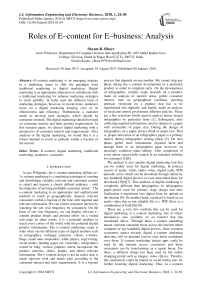Roles of E–content for E–business: analysis
Автор: Shyam R. Sihare
Журнал: International Journal of Information Engineering and Electronic Business @ijieeb
Статья в выпуске: 1 vol.10, 2018 года.
Бесплатный доступ
E–content marketing is an emerging strategy in a marketing arena to shift the paradigm from traditional marketing to digital marketing. Digital marketing is an appropriate alternative to collaborate with a traditional marketing for enhance marketing strategies to reach globally. In India used the different kind of marketing strategies, however, in recent times, marketers focus on a digital marketing keeping view of its effectiveness and efficiency. Furthermore, a marketer needs to develop such strategies which should be consumer oriented. The digital marketing should be based on consumer interest and their product requirements. In this research paper, we discuss digital marketing with a perspective of consumer interest and requirements. After analysis of the digital marketing, we found that it is a robust medium to reach as globally within a fraction of the second.
E–content, digital marketing, traditional marketing, marketers, consumer
Короткий адрес: https://sciup.org/15016119
IDR: 15016119 | DOI: 10.5815/ijieeb.2018.01.04
Текст научной статьи Roles of E–content for E–business: analysis
Published Online January 2018 in MECS
As per Wikipedia, the e–content marketing defines as– “e–content marketing is a marketing technique of creating and distributing valuable, relevant and consistent content to attract and acquire a clearly defined audience – with the objective of arriving profitable customer action.” The e–content marketing is an appropriate and sophisticated medium to reach to geographically disperse relevant consumers within a fraction of the time with required and relevant information. We can collect consumer interest by watching the site visit frequency by consumers. On the basis of site visit frequency, we can display relevant e– content product details and product offers on a visited web page. In other words, it is a potential medium to reach every corner of the world with the potential digital product information. The e–content marketing scope is wide when use the different types of digital medium such as infographics, webpage, podcasts, videos, e–books, blogs, email auto–responders, white papers, copywriting, social media, landing pages etc. Generally, infographics would be long, vertical graphics where incorporate the product statistics, charts, graphs, and others relevant information. The e–content design is not an easier task, it needs rigorous work and makes plan according to the consumer interest and their requirements. It is a layered process that depends on one another. We cannot skip any phase during the e–content development of a particular product in order to complete early. On the development of infographics, initially make research on a product, make an analysis of specific areas, gather consumer interest, look on geographical condition, gawking political viewpoint on a product that has to be transformed into digitally, and finally, make an analysis of local and central government different policies. These are a few criterions which need to analyze before launch infographics by particular firms [1]. Subsequent, after collecting required information; need to design on a paper with constraints of paper size. During the design of infographics on a paper always think of paper size. That is, proper utilization of an infographics paper is a primary motive during infographics writing phase [2]. On next phase, gather more information, organize them and arrange them in an infographics page, however, on necessary condition make editing. After completion of every phase successfully launch in an intended websites for consumer [3][4].
The podcast is also another digital marketing tool that can be widely used for digital marketing. In podcast consist of audio, video, audio–video, digital radio, PDF episodic series which can be download through online by any handheld digital devices or even subscribed these for download [5][6][7]. This medium of digital marketing is completely different than infographics. In infographics paper–pencil used for primary stage design and after finalization it transforms into digital form for upload on the internet [8]. On another hand, a podcast is based on an audio–video clip or not editable file ( i.e. PDF files) or a combination of both [9][10].
These are a very few medium that can be used for digital marketing or e–content marketing, lots of others alternatives also available on an internet that has mentioned above. Through these e–content marketing attract common consumer those access the internet either computer or any handheld digital devices. Once common consumers attract towards digital e–content marketing then they will be attached forever once build confidence over them. E–content marketing design apps could be used by the internet access consumers and those consumers can be transforming as a repeat buyer. For these, a different things has been used by the online shopping portal such as images, video clip etc. Thereby, this mechanism could be launch in social media sites for further fostering digital marketing. Thus, in e–content keep those things that we want to sell to consumers. Through this, we can educate common people about different products to know more about that product by which they can easily compare with retail shops available products. Once they like your product, build a confidence and make business with you [11][12][13].
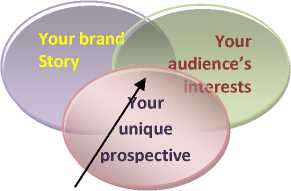
A great piece of content
Fig.1. E–content marketing strategies
E–content marketing in recent times is demanding and it is also an emerging mechanism in perspective of e– business, e–learning and e–teaching process. In e– teaching and e–learning process consist of different audio, video streams which being developed by professionally skilled persons, after that, distribute them among students and entrepreneurs to know more about students and buyers mentality and design e–content as per their demands. The e–content marketing divide into three sections as follows for root understanding [14][15] (fig. 1)–
-
1) Your brand story
-
2) Your audience’s interests
-
3) Your unique perspective or content medium
Among these three entities, consumer requirements play a significant role for development of e–content. We need to extract most excellent things from three well– known entities as per customer interest and their requirements.
In contrast of this, traditional marketing should adapt recent times technologies for marketing. That is, companies need to switch from traditional marketing to the electronic marketing. By adaptation of the e–content marketing, business sales and purchase transaction would be complete within a short span of time. On effect of this, business grows very rapidly within a short span of time without any geographical hurdles that have been come across during traditional marketing. This could be done by the digital marketing or e–content marketing through merging of traditional marketing and cultural marketing [16].
However, for e–content marketing need a creative approach for design product in electronic form, by which, intended customer create interest to know more about that product by clicking on an electronic page. If everything seems good by intended customers, then that intended customer change as forever customer and business prosperity could go on very well. This electronic design plays a significant role into B2B and B2C business for grow them within very short span of time [17][18].
At first glance, it does not look an appropriate method for promoting business sale. However, digital marketing impacts look in future sales of a product. Every corner of the world look your digital products and take a time to analyze your product, later on look another company same product, make a comparative analysis of both products and at last arrived at a final conclusion. This system does not show instant impact but its impact look into future once your company adopts this strategy. Nevertheless, for grow sales, company should adopt a sophisticated digital mechanism and make an analysis of surrounding. It is a significant phenomenon of any type of company. A company need to transform from traditional marketing strategy to digital marketing by application of podcast, infographics, auto message service, SMS, telephonic call etc [19].
The e–content development strategy should revolve around a consumer requirement and market orientation. Hence, same e–content marketing for all geographical places is not the appropriate choice. The e–content development strategies changes as per geopolitical ground. The e–content marketing strategy should be changed frequently as per market analysis and consumer requirement analysis in order to sustain in a market and a digital world. Therefore, for market strategy, we need to give answers of following questions with respect to e– content marketing strategy to place business in a significant position–
-
• How build your first e–content marketing strategy?
-
• How build a Kickass e–content strategy?
-
• How grow your personal brand with the e–content strategy?
Above e–content marketing questions answers should be useful in B2B and B2C businesses sector for promoting their products. However, according to e– content marketing survey, B2B sector are more suitable and successful for e–content marketing on a comparison of B2C sector. In B2B, content marketers have two things in common: first, someone needs to oversee of e–content marketing strategy, second, that strategy needs to be documented. In fact, less than 100 employees small scale company needs to supervise by someone on e–content marketing ( i.e. however, at present, 78% companies of this type not supervised on e–content by someone). On other hand, large scale company ( i.e. more than 1000 employees) this could not occurred more frequently ( i.e. 58% companies of this type not supervised on e–content by someone).
Handheld devices ( i.e. mobile devices) also play significant roles in e–content marketing if apply following points on development of e–content with respect to handheld devices ( i.e. mobile device) because most of person in recent times used handheld devices and they access internet due to enhancement of mobile phone functionalities–
-
• Exit from traditional application of mobile and develop a new mindset
-
• Recognize stress between lengthy and short form content
-
• Comprehend customer mobile routine
-
• Focus on main e–content
-
• Find opportunities and do work as per customers requirement
-
• Incorporate different content in proper length
-
• Do not ignore the power of e–content design
-
• Proper understand the reading level of customers
-
• Institute audio, video or audio–video content in e– content development
-
• Use secondary screen for proper understanding the e–content design
As above discussion, it is obvious that traditional marketing strategies are not sophisticated medium, we should adapt digital means for better prospect of business. In this article, we discuss objective of research in section II, related work in section III, methodology, and results in sections IV, V respectively.
-
II. Objective(s) of Research
The e–content marketing has played significant role for online marketing. Nowadays marketing strategies rapidly changes so that it needs to adapt new alternatives for promote their company products. After 2015, marketing strategies has been changes and adapt it by most of the small scale industries, medium scale industries as well as large scale industries. Those businesses take support of new technologies will be survived in future therefore it is compelled to embrace new digital marketing strategies. The e–content marketing is not much expensive as compare to traditional marketing and its return also a huge. This would be beneficial of those companies who invested hugely on traditional marketing. There is no matter what types of companies, how many human resources work there. The matter is that, what type of marketing strategies should be applied by company for product endorsement. The marketing strategies should be market oriented and budget oriented to meet customer demands. And for this, only e–content marketing would be an appropriate choice due to its efficiency and cost– effectiveness. Furthermore, e–content marketing scaled according to your business and company budget, we can develop and design e–content with the help of e–content designer. Hence, every options is available according to your budget (fig. 2) –
-
• 82% e–content marketing use by B2B marketers
whereas 92% by enterprise marketers.
-
• Traditional content is the prospect of marketing industry as such concept believed 82% business CMO’s.
-
• 12% companies avoid e–content marketing at
recent times.
-
• Despite of e–content proved valuable, only 32% marketers think that they are valuable approach.
Visual e–content play an important role for marketers, hence, 94% marketers used e–content as e–visual. It simplifies the complex concept in a simple, precise and concise ways. Digital technology evolving at a rapid pace and the marketers find a new opportunity to tell stories by video, infographics and compelling imagery.
Traditional marketing appear somewhat extent as outdated when make analysis of a market about product details sophistication. Most of the users have digital equipment in various forms such as mobile, fabs, laptop, palmtop, desktop etc. for compliance of their daily needs. To reach common consumers as efficiently and effectively then digital marketing is an appropriate alternative available in today’s market. In the digital arena, an e–content marketing is an emerging phenomenon.
Hence it is essential to search a market place where it is needed to implement.
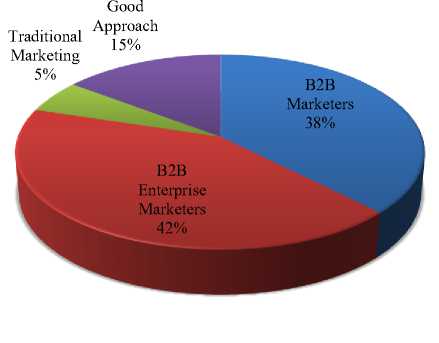
Fig.2. Marketers believed or not believed on e–content or digital marketing
-
III. Related Work
E–content needs high–tech technology for draft high– quality content for educate and acquires targeted customers. The e–content marketing does not only create productive content but find true potential of marketing by which attract targeted customers. Its main purpose is to provide good and meaningful information as per the convenience of targeted consumer [20].
The e–content marketing ultimately promotes business or product brand through digitally by value basis text, audio, video or audio–video ways as online or offline mode. It is in a long form such as blogs, articles, e–books etc. Similarly, it can also create in a short form such as Twitter updates, Facebook updates, images etc. Even, e– content marketing uses the conversational form such as sharing content via Twitter; make active discussion via blog comments, participating in online forum etc [21].
Due to digital communication and networks evolution, e–content marketing has also frequently changed their strategy as per requirements of digital media and digital techniques. Due to digital technique can reach every corner of the world instantly without any geographical barriers according of consumers requirements and interest [22][23][24]. The e–content information need to be change in accordance with technical changes.
Through e–content marketing the dynamic way share expertise information for attract and connect potential customers. According to e–content marketing policy, e– content should be in recycled through that public users could be re–used it, effect of this, maintain customers interest [25].
Traditional marketing is not enough to promote a product in an attractive way. We must adapt a digital technology for marketing and selling products as online and offline mode [26].
We can create value co–creation by a participation of potential customer with expertise e–content designers. The potential e–content has been complete by mutual coordination and cooperation between e–content designers, customers, related firms etc. Hence, create e– content design by creativity, capture proper information on time, delivery of potential information to intended e– content designers, after that, information make digital customization and at last time–to–time make management are some key factors which play a crucial role during and after e–content development. Through that, convey reliable messages to customers about the company and even it makes useful to the customers [27].
As per [22][28][29][30] industries employ digital e– content for marketing to meet multiple objectives of the companies by a single platform. In multiple objectives, we incorporates brand understanding, make lure to customers etc, in addition, make a relationship with customers, hence, potential customers make marketing of company products in surrounding as directly or indirectly.
According to above literature review, we can state that e–content marketing is an attractive medium if involved deeply into it as per customer requirements, markets and firms demand, eventually company make a profit.
-
IV. Methodology
To know how Indian companies comprehend e–content marketing, we need to determine its impacts in a company execution by survey as online questionnaire. We conducted survey around 1,000 Indian companies with the marketing manager. In a questionnaire included 20 different types of questions which were further divided into two parts: in a first part, consist of five different multiple choice questions. These five questions are miscellaneous ( e.g. gender, age, size, business sector, geographical areas etc.) by which obtain general information of that person who responds the rest of the e– content related questions. In second parts, consist of fifteen questions and that questions response measured by the Likert scale, after that, make analyze of them. Some questions sample are listed below for more understanding of the rest of questions–
-
1) What is e–content marketing and how important in firms for marketing?
-
2) Can e–content marketing be an effective medium for marketing?
-
3) If e–content marketing is effective then how marketers rate effectiveness of e–content marketing of their business?
-
4) Which way determine by marketers about e– content marketing strategies?
-
5) What type of strategy used by e–content marketers to accomplish their target?
-
6) How much budget has been allotted for e–content marketing?
As such different types of questions have been asked through online mode to collect data for better understanding e–content marketing. Initially, respond rate by marketers were not so appreciable but with time respond rate has been exponentially grow. That is, initially 18% (180 firms) firms respond of questionnaires. At last, the final respond rate was 20% (202 firms). After that, we analyzed and checked potential non–respond customers and what were biases by which they did not responded the questionnaires. It was divided into three parts as early responders, late responders and not responders. We made treatment of late responders as not responders and not included in a sample for further analysis. There was no statistical different between late responders and not responders, hence, late responders have some biases regarding this mechanism. So that, late responders, we treat as non–responders. Furthermore, non–responders experienced major problems for the analysis of data of the e–content application in a firm [29][30].
As a final point, acquired a concluding sample of 202 Indian companies such as (Table 1)–
Table 1. Sampling of digital marketing usage in India in different size organizations
|
Business Sector |
N (%) |
|
Manufacturing |
25 (12.38%) |
|
Publishing Media/Internet/Online services |
30 (14.85%) |
|
Accounting/Banking/Financial |
30 (14.85%) |
|
Advertising/Communication/Marketing/PR |
117 (57.92%) |
|
Size (by Employees) |
|
|
Micro (fewer than 10 employees) |
20 (9.90%) |
|
Small (10–50 employees) |
90 (44.56%) |
|
Medium (50–250 employees) |
60 (29.70%) |
|
Large (more than 250 employees) |
32 (15.84%) |
|
Geographical Area |
|
|
North India |
51 (25.25%) |
|
South India |
51(25.25%) |
|
West India |
50 (24.75%) |
|
East India |
50 (24.75%) |
|
Job Title |
|
|
CEO |
92 (45.55%) |
|
Marketing Manager |
110 (54.46%) |
-
V. Results
From above questionnaires, the result would be appreciable to know and use of e–content marketing to promote the new product and frequently revitalization of existing e–content information. On analyzing of how marketers rate their organization to use e–content marketing, Table 2 results show that respondents respond that e–content marketing is very effective (25%), effective (30%), low effective (45%) and not at all effective (15%).
Table 2. Sampling of e–content marketing usefulness in business sectors
|
Use of e–content between Indian Firms |
67% |
|
Rate |
|
|
Very effective |
15% |
|
Effective |
25% |
|
Low effective |
45% |
|
Not at all effective |
15% |
The main purpose of e–content development is to know more about product brand (88%) and customer retention/loyalty (74%) and product sale (75%) as stated in Table 3. The website traffic (45%) and thought leader (40%) does not play significant role for e–content marketing.
Table 3. Top goals of e–content marketing
|
e–content marketing goals |
Value |
|
Brand awareness |
88% |
|
Customer acquisition |
70% |
|
Sales |
75% |
|
Customer Retention/Loyalty |
74% |
|
Lead Generation |
60% |
|
Lead Management/Nurturing |
55% |
|
Website traffic |
45% |
|
Thought leader |
40% |
If adapt social media for brand endorsement then there are number of benefits has been received at company end. The masses of electronic device users know about brand of the products. Subsequently, potential customer attach with the company products as in electronic way. Proportions of customers search of particular products has been grown on online, consequent of this, sales rate automatically grow over time. It is the liabilities of company to provide good services to the customers as for products and services, on effect of this, customer retention remain in long–time with the companies. Among all these, brand awareness has been increase many fold when adapt the electronic way of product endorsement ( i.e. around 90%).
Different kinds of e–content could be designed. However, the e–content design should resemble of those digital media where we make a plan to upload them. Most of the e–content marketing used the social media (90%) for a better endorsement of their company product as indicated in fig. 4.
e-content marketing goals
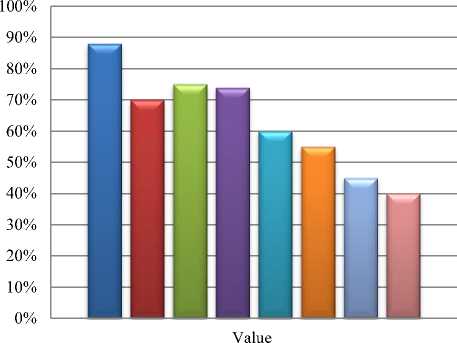
u Brand awareness м Sales и Lead Generation м Website traffic и Customer acquisition и Customer Retention/Loyalty ы Lead Management/Nurturing н Thought leader
Fig.3. Top goals of e–content marketing
By evolved of electronic device, different ways product would be endorsed electronically. However, for different electronic platforms need different e-content design strategies. It is an inappropriate to stick same design for different electronic media. Abruptly, traditional marketing method has been changed as electronic for product endorsement. For e–content marketing social media, blogs, eNewsletters, Articles on your websites, Videos, Infographics, Online, e–Books, Mobile content, Research report, Webinars/Webcasts, Podcasts, Articles on other Website and Mobile Apps are some platform(s) which can be widely used for marketing of different types of services, product etc. Among all these, social media contributions are high because its users are high as compared to the others application which is indicated in Table 4 and fig. 4.
Table 4. E–content marketing tactics
|
e–Content Marketing Tactics |
% |
|
Social Media Content |
90% |
|
Blogs |
85% |
|
eNewsletters |
80% |
|
Article on your website |
70% |
|
Videos |
88% |
|
Infographics |
72% |
|
On–line |
74% |
|
e–Books |
60% |
|
Mobile content |
80% |
|
Research Report |
68% |
|
Webinars / Webcasts |
60% |
|
Podcasts |
71% |
|
Article on other Website |
50% |
|
Mobile Apps |
80% |
100%
90%
80%
70%
60%
50%
40%
30%
20%
10%
0%


Fig.4. E–content marketing tactics
The prespective of India inhouse e–content design groomed more and design e–conent for marketing are more ( %) as compare to the outhouse e–conent design (25%). Because Indian market rapidy switch toward electronic marketing due its cos effectiveness and global reach (fig. 5).
u Inhouse и Outhouse Li Both
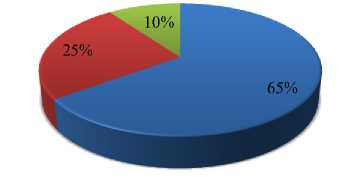
Fig.5. Comparative study of in–house and outsources design of e– content design.
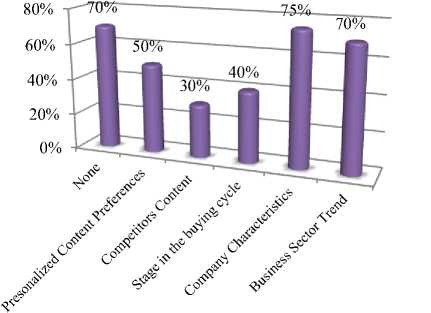
Fig.6. Percentage of documented and planned e–content marketing strategy
-
VI. Conclusion
From above discussion, it is obvious that traditional marketing is not effective to reach effectively and efficiently due to various geographical constraints. If traditional marketing would be collaborating with the e– content marketing then marketer strategies make robust and production sale grows.
In India, a firm should be a focus on e–content marketing to grow sales rate and fulfill consumer requirements. The e–content marketing needs to be modified frequently as per consumer interest and their demands. However, for e–content marketing proper strategies should be developing, in other words, e–content engineering applies for suitable e–content design. Without e–content engineering, we cannot plan appropriate content and related information.
According to [20] e–content marketing being groomed more in western areas compared to South Asia region. Hence, Indian firms should change their marketing strategies as e–content marketing instead of traditional marketing. The Flipkart, Amazon, Snapdeal are online shopping portals used e–content marketing to promote their products.
Список литературы Roles of E–content for E–business: analysis
- Smiciklas, Mark. The power of infographics: Using pictures to communicate and connect with your audiences. Que Publishing, 2012.
- Lankow, Jason, Josh Ritchie, and Ross Crooks. Infographics: The power of visual storytelling. John Wiley & Sons, 2012.
- Krum, Randy. Cool infographics: Effective communication with data visualization and design. John Wiley & Sons, 2013.
- Siricharoen, Waralak V. "Infographics: An approach of innovative communication tool for e–entrepreneurship marketing." International Journal of E–Entrepreneurship and Innovation (IJEEI) 4.2 (2013): 54–71.
- Kozinets, R. V., De Valck, K., Wojnicki, A. C., & Wilner, S. J. (2010). Networked narratives: Understanding word–of–mouth marketing in online communities. Journal of marketing, 74(2), 71–89.
- Feifan Xie, Philip, and Alan A. Lew. "Podcasting and tourism: An exploratory study of types, approaches, and content." Information Technology & Tourism 10.2 (2008): 173–180.
- Chang, Shuchih Ernest, and Muharrem Cevher. "An investigation and conceptual models of Podcast marketing." Advances in Web and Network Technologies, and Information Management. Springer Berlin Heidelberg, 2007. 264–275.
- Geoghegan, M., Cangialosi, G., Irelan, R., Bourquin, T., & Vogele, C. (2012). Podcast academy: the business podcasting book: launching, marketing, and measuring your Podcast. CRC Press.
- Sampson, Jo Ann. "Launching into the Podcast/Vodcast Universe." Computers in Libraries 26.10 (2006): 10.
- Miller, Michael. B2B digital marketing: Using the web to market directly to businesses. Que Publishing, 2012.
- Chaffey, Dave, Paul Russell Smith, and Paul Russell Smith. eMarketing eXcellence: Planning and optimizing your digital marketing. Routledge, 2012.
- McQuade, S., Waitman, R., Zeisser, M., & Kierzkowski, A. (1996). Marketing to the digital consumer. The McKinsey Quarterly, (3), 4–5.
- Ryan, Damian. Understanding digital marketing: marketing strategies for engaging the digital generation. Kogan Page Publishers, 2016.
- Akar, Erkan, and Birol Topçu. "An examination of the factors influencing consumers' attitudes toward social media marketing." Journal of Internet Commerce 10.1 (2011): 35–67.
- Hosken, Benjamin E. "Automated content and collaboration–based system and methods for determining and providing content recommendations." U.S. Patent No. 6,438,579. 20 Aug. 2002.
- Chung, Tze, and Ying Wai Ip. "Media playing system and method for delivering multimedia content with up–to–date and targeted marketing messages over a communication network." U.S. Patent Application No. 11/145,827.
- Taipina, M. S., Lamardo, L. C., Rodas, M. A., & del Mastro, N. L. (2009). The effects of gamma irradiation on the vitamin E content and sensory qualities of pecan nuts (Carya illinoensis). Radiation Physics and Chemistry, 78(7), 611–613.
- Jefferson, Sonja, and Sharon Tanton. Valuable content marketing: How to make quality content the key to your business success. Kogan Page Publishers, 2013.
- Shiratuddin, Norshuhada. "E–books in higher education: Technology, e–marketing prospects, and pricing strategy." Journal of Electronic Commerce in Organizations 3.2 (2005): 1.
- Ramos, Rick. Content Marketing: Insider's Secret to Online Sales & Lead Generation. One Night Expert Publishing, 2013.
- Gunelius, Susan. Content Marketing for Dummies. John Wiley & Sons, 2011.
- Rakic, R., R. Beba, and R. Mira. "Digital Content Marketing for organizations as buyers, Ekonomika." Journal of Economic Theory and Practice and Social Issues 1 (2014): 109–123.
- Koiso–Kanttila, Nina. "Digital content marketing: a literature synthesis." Journal of Marketing Management 20.1–2 (2004): 45–65.
- Rowley, Jennifer. "Understanding digital content marketing." Journal of marketing management 24.5–6 (2008): 517–540.
- Slater, D. "Content marketing: recycling and reuse." New York: i30 Media Corporation (2014).
- Lieb, Rebecca. Content marketing: Think like a publisher–How to use content to market online and in social media. Que Publishing, 2011.
- Parkin, Godfrey. Digital marketing: Strategies for online success. New Holland Pub Ltd, 2009.
- Kucuk, S. Umit, and Sandeep Krishnamurthy. "An analysis of consumer power on the Internet." Technovation 27.1 (2007): 47–56.
- Rancati, Elisa, Niccolo Gordini, and Alexandru Capatina. "Conceptualizing and Measuring Content Marketing in Luxury Firms: An Exploratory Analysis." Global Marketing Strategies for the Promotion of Luxury Goods. IGI Global, 2016. 109–132.
- Rancati, Elisa. "Market–driven management, global markets and competitive convergence." (2010).

